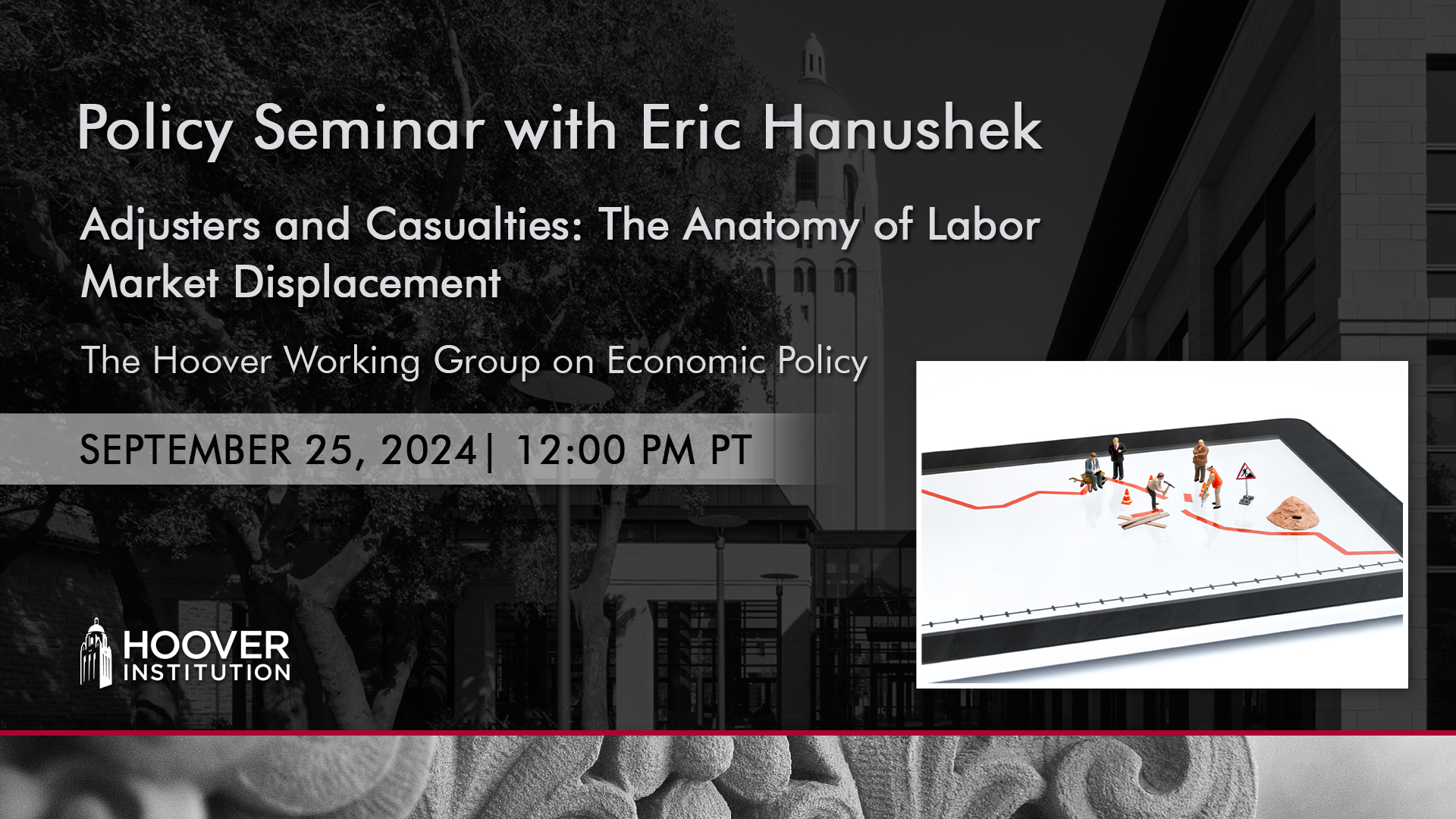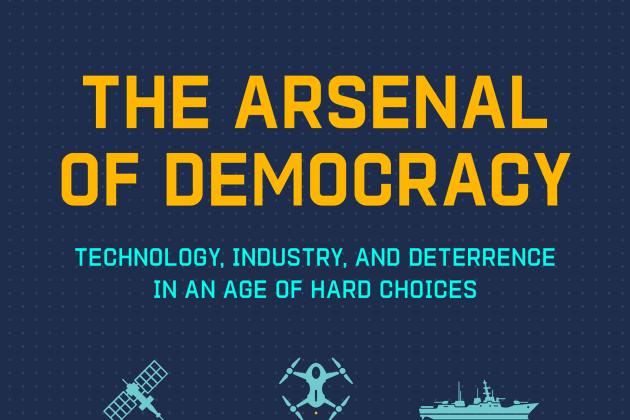PARTICIPANTS
Eric Hanushek, Jacob Light, John Taylor, Annelise Anderson, Uschi Backes-Gellner, Eric Bettinger, Valentin Bolotnyy, Hoyt Bleakley, Michael Boskin, John Cochrane, Sami Diaf, Michael Droste, Elizabeth Elder, Jared Franz, Nick Gebbia, Jerome Greco, Theocharis Grigoriadis, Bob Hall, Jon Hartley, Robert Hodrick, Norbert Holtkamp, Nicholas Hope, Simon Janssen, Ken Judd, Dan Kessler, Anjini Kochar, Evan Koenig, Marianna Kudlyak, Nelson Layfield, Charles Leung, Ross Levine, Mickey Levy, Alexander Mihailov, Brendan Moore, Daniel Morabito, Stephen Redding, Paola Sapienza, Jack Tatom, Yevgeniy Teryoshin, Ramin Toloui, Alexander Zentefis, Chiara Zisler
ISSUES DISCUSSED
Eric Hanushek, the Paul and Jean Hanna Senior Fellow at the Hoover Institution, and Jacob Light, Hoover Fellow, discussed “Adjusters and Casualties: The Anatomy of Labor Market Displacement,” a paper with Simon Janssen (Institute for Employment Research) and Lisa Simon (Revelio Labs).
John Taylor, the Mary and Robert Raymond Professor of Economics at Stanford University and the George P. Shultz Senior Fellow in Economics at the Hoover Institution, was the moderator.
PAPER SUMMARY
Earnings losses after job displacement are highly skewed: a small number of workers experience catastrophic losses, while most workers recover quickly. Thus, average earnings losses as commonly estimated by event studies significantly overstate the losses for a majority of displaced workers. This paper documents the heterogeneity in earnings losses after job displacement and the behavioral differences underlying these adjustment differences. We study workers from firms in West Germany that closed between 2000-2005. By creating a synthetic control for each laid-off worker from similar workers who were not laid off, we can estimate the full distribution of economic losses. As found in other analytic approaches, older, less educated, and female workers suffer larger average losses, but a key result in our analysis is the remarkable overlap of the demographic loss distributions. Fixed characteristics do not predict which workers will experience the greatest losses; instead, these losses are associated with post-layoff adaptability, such as switching professions or geographic relocation.
To read the paper click here
To read the slides, click here
WATCH THE SEMINAR
Topic: “Adjusters and Casualties: The Anatomy of Labor Market Displacement”
Start Time: September 25, 2024, 12:00 PM PT
>> Eric Hanushek: I was going to start, and then Jacob will take the hard questions, of course.
>> Eric Hanushek: And Simon, co author, is up high in the balcony up there.
>> Eric Hanushek: Lisa is not here. So we should start out that this is a failed research project. Some number of years ago, uncountable, I think we, Jacob and I and Lisa, started on a project to, in fact, investigate the lifelong learning that goes on in Europe.
This is sort of a mantra if you go to Europe, that they have a lot of vocational education, and people should constantly be learning new things to prepare for changes in the labor market and so forth. And to our knowledge, there was no evidence that it ever occurred.
So we set out to try to investigate this issue and spent two years and couldn't find it. And so this is the substitute project for the failed research project that still has in basket, it's under a file called lifelong learning. So someday I won't be able to find it because of that.
What we're about today is to look at basically what happens when workers are displaced and the way this comes to the failed project. The failed project had the idea that if you take all of the people who were in firms that were closed, these were the people that had to adjust if anybody had to adjust by looking at just workers in closed firms, and we couldn't find that anybody was adjusting very much to the fact that eventually they were going to be thrown out on the street.
So today's project, though, then we turn to the other side of this to look at, well, what happens when people were thrown out onto the street, and did they adjust then, and what kinds of adjustments were made after firms closed? So we're gonna follow what is a fairly large literature on worker displacement.
We're going to, the previous literature has documented the fact that, on average, it's not a good thing to have your firm close on you. And beyond that, it's not a good thing if you are low educated person, a woman or older person, that those are bad things to be if your firm is going to close.
And then there's some added work that we're missing Steve Davis here. But Steve was one of the first to look at how does the cost of being thrown out on the street vary across the business cycle? And it's not a good idea to be thrown out in a bad time in the business cycle.
>> Speaker 2: Clarification, I would guess low education people have less firm specific capital. Janitor, you can be janitor anywhere, high education would get hurt more by losing that first firm specific knowledge, but that's not true.
>> Eric Hanushek: That's not true, that's not what happens I mean, nobody's really identified firm specific human capital very well, anyways.
But no, that's not true, the general education, the general skills are the ones that are more important in terms of subsequent adjustment.
>> Speaker 3: Do you have any evidence on how much notice people had their?
>> Eric Hanushek: None, in fact, it takes a lot of work to figure out which firms have actually closed, I'll get to that in a second.
>> Speaker 3: You're gonna look at actually firms that go out of existence, not plants, firms.
>> Eric Hanushek: Firms.
>> Speaker 3: Generally, a very large fraction of adjustments in labor markets is by firm shutting down divisions or by shutting out a specific factory one out of seven or something. Do you have any evidence on that?
>> Eric Hanushek: None, no.
>> Speaker 3: Can you define age and old? Has that changed or is that the same?
>> Eric Hanushek: I'm old, no, we'll show you some evidence on age later. We have a sample that starts out at 21 to 55 and looking at what happens to them. So they're general working for us people.
We're gonna be looking in Germany and there's no such thing as age past age 65, that's it. So we're gonna look at normal employment ages. So what we're going to do is the problem in all of this literature and what makes the multiple papers, in essence, is little nuances on how you define the control group that the comparison group to where you're at, and then some details on that.
And that's the question, to whom do you compare a displaced worker? And that's the heart of this paper, actually, of how you do that. The standard approach is to look at displaced workers and compare them to all other non displaced workers, maybe of similar age and so forth.
There's some modifications and refinements on that, some of which we're going to build on here, but we're going to do something quite. And then you just do a difference in difference, sorry, event study of the closure and see what happens to the displaced workers compared to when they're to workers that aren't displaced.
We're going to try to do something different. What we're gonna do is to go to the synthetic control group literature and we're going to first group workers by somewhat similar non-displaced workers, our displaced workers, and then we're going to develop a synthetic control for each worker and we'll show you that we can in fact have reasonable controls out of this.
And what that allows us to do is to trace the entire distribution of economic losses. The other literature for the most part, looks only at mean losses. Average losses. You're comparing the average of a displaced worker to everybody else? Or the average of a woman who's displaced to all other women that are.
That aren't displaced. And what we're gonna try to show you is that the average can be quite misleading as to what the cost look like, because the distributions basically aren't normal. And because of that, you get a very different picture if you look at the whole distribution. So that's where we're gonna get to by the end and convince you that, in fact, you have to go beyond the mean.
There's this, as I say, big literature that looks at overall closures, education, gender, tenure. This is the slide that everybody who's in the room who's written in the area should be listed there, John.
>> Speaker 2: The usual unobservable is problem, I would imagine, a plant starts losing money, we can all know what's happening.
Anybody who can get a job leaves. By the time the plant actually closed, the only people left in the plant are the nudniks, and no wonder they have trouble getting jobs afterwards.
>> Eric Hanushek: That's a little footnote to why your intuition is wrong, but we'll get to that at the very end.
Essentially, very few actually leave these firms in the year or two leading up to their firm closing. The firms close because the workers aren't very good, this is certainly a possibility to worry about, right? We'll get to that, a little bit earlier in the talk. We're going to get to that.
>> Speaker 3: What can you or anyone else can do about that?
>> Eric Hanushek: There's a lot we can do about it. We can compare these people to their synthetic controls that look the same in terms of past earnings and past education, occupations, and industries. And we can show you that a quarter of these workers have good unobservables, that they actually come out ahead, and there's a group that are really harmed.
So we'll give you that picture in just a minute. We won't be able to label it any better than you did of, what are the characteristics of these people, but we will be able to do that. Anybody else wanna guess at where we're going?
>> Speaker 4: I don't know the data, but just a question on controls, is it possible to do something like staggered exit of firms?
So you compare a firm that's exited to a firm that's exited or is about to exit, you know it, but they didn't like two years earlier and do that kind of.
>> Eric Hanushek: Yeah, I mean, we're doing something similar to that. We're not looking at the firm level, but we are in fact looking at something similar, I think, to what you want.
>> Speaker 2: Just to set the overall framework using my first five years.
>> Eric Hanushek: Yes.
>> Speaker 2: So, data on how many workers were displaced for whatever reason, from whatever, whether a firm closed, a plant closed, something happened, versus the subset that you're dealing with from the entire firm close. What fraction of the displacement are you catching?
>> Eric Hanushek: Let me define the sample, I'll get back to your question. The thing that we don't do that lots of the rest of the literature did was to combine firm closures with mass layoffs. And we look entirely at firm closures because of John's problem here, that you would expect, if there's a mass layoff, that means some of the people are still there.
And you might expect them to be, the people laid off are negatively selected. And so we-
>> Speaker 2: So it's just a factual, empirical question.
>> Eric Hanushek: Well, they-
>> Speaker 2: If there were a million displaced.
>> Eric Hanushek: We capture everybody who left a firm with at least 50 employees. That closed.
That closed.
>> Speaker 3: Mike's question, if I got it right, what fraction of total unemployment?
>> Eric Hanushek: Except the problem is, what's the denominator in that calculation? We know we have all of the workers who are in firms of 50 employers or more, and a little slightly other things. And, to whom do you wanna compare that?
If we compare it to all of the other firms with at least 50 employees, we're talking roughly 3% of the total employees in firms with 50 employees we're seeing as being displaced.
>> Speaker 2: But can you displace by firm closure, not displaced? There are other reasons people are displaced.
If you have 15 factories and you shut one, those people don't get reassigned.
>> Eric Hanushek: Yeah, no, no, this is firm closures, so I As opposed to just people who are unemployed individually. I mean, the problem is that we don't know what the denominator is going to be.
>> Speaker 3: We don't know what we're quits, what were layoffs, etc, I appreciate that.
Still, some notion of the scope of your analysis relative to the overall labor market. You might have causal effect, you don't want how much of everybody the labor market rejects. You wanna know, if I fire one guy, what happens to him? And if you had a CSD sample of one, that would be fine.
Not that, I'm just trying to get a picture of what.
>> Eric Hanushek: So, Jacob can try, I've done my best here. It's somewhere between 1 and 3% of the population each year.
>> Jacob Light: I think Michael's question, the challenge, of course, is that in our administrative data, we're not able to observe mass layoffs in a clean sense.
And distinguish it from other reasons that the firm head count might be contracting. But I think we should think about this as about half of employees who are being eliminated from firms of this size, whether it's a full closure versus a headcount reduction of 30% or more. Okay.
And Simone can jump in if that's wrong, but my recollection is that that's about what we're thinking.
>> Simon Janssen: Yeah, it cannot be more than 30% that end up in a subsequent form, that's the same. We would not classify that as closure, because that's probably more like outsourcing or something else.
>> Eric Hanushek: Okay, let me define the sample first, and then we can come back to these questions if they're important. But a noticeable percent of the population is in firms that are closed each year, and that's what we're trying to observe. So this is a list of past studies, the headings are the important thing.
We can reproduce everything that's been done before for these studies within our sample and our data. There's a couple that we cannot reproduce, and that is, There have been some studies, including one by our co author Zemon, who look at country specific institutions and whether that affects the economic losses that occur from closure.
And then the same thing that Steve Davis and Till Van Rochter looked at, how the business cycle affects this, because we're only going to look at one period of time, we can't reproduce those estimates.
>> Speaker 2: What was the discussion of that paper?
>> Eric Hanushek: Did you approve of it at the time or not?
>> Speaker 2: Great, but. Well, there's things I can tell you.
>> Eric Hanushek: Okay, so the standard, recognizing that everybody wants to guess at the answers, I'm going to give you all the answers and then you have to guess at how we got to that answer as we go along here.
But what we're going to find is the loss distribution is rather bi-modal and that the outliers are driving these averages. And that's why it's kind of misleading. 20% of the workers in our sample actually come out ahead after closure. They have positive earnings above their controls, their synthetic controls, and then it's the big outliers that are hurting you.
The observed characteristics that led to all of the past literature actually explain very little of the differences. We can reproduce the average effects they get, but that doesn't explain much about the distribution of losses that are occurred that occur. If I look at the standard of age, gender and education that we talked about before, they explain less than 2% of the total losses that we see, and 98% comes from something else.
And the, a number of the studies, including recent one in the AER by Schmeider et al. Suggests that firms have a big effect on this. And they try to trace whether if you're in a good firm and get sent off to a bad firm, how much of that has to do with the losses.
And we'll look at that. They do have some impact, but i it's not the impact that you're gonna guess. So I'll cut off guesses on that for a moment. And then what we do, which is maybe non standard in today's world of causality, is that we define the displaced workers into different quartiles of the distribution.
And we try to look at what do we see as adjustments by the people that come out ahead in the top quartile, lowest losses versus those that have the big losses and what's driving the differences there or what's consistent with them. We're not gonna make any causal claims that these are the things, but we're going to just trace out how much comes from changing regions, occupations and so forth and a little bit about getting education and other things.
But that's where we're going, yes.
>> Jacob Light: Do you have information about wealth and household income? Just my spouse?
>> Eric Hanushek: No, we don't. That doesn't come within our data, yes.
>> Speaker 3: Two questions, the first, the question always in this literature. So these losses are conditional on future employment. Yes, you're not putting in the future zeros where some people drop out of the labor force, is that right?
>> Eric Hanushek: That is not right.
>> Speaker 3: You're averaging in the zeros.
>> Eric Hanushek: Yeah.
>> Speaker 3: Okay, you have results where often what you'll do is you'll take the log and then you're just dropping.
>> Eric Hanushek: Yeah, we will later on show you what comes from not observed out of the labor force.
>> Speaker 3: It doesn't meaningfully change.
>> Eric Hanushek: Yep.
>> Speaker 3: Okay, and then the observed characteristics explaining very little. I think it's interesting results and then kind of by correlation, that also would suggest that there's not much demographic difference between adjusters and the casualties or are you gonna show us?
>> Eric Hanushek: We'll show you that, I'll show you where we are, yeah.
There isn't, by the way. So here's what we're doing. We're taking the integrated employment biographies in Germany. This is their social security records which follow individuals over time and have lots of information about wages and social security payments and so forth. It has a few flaws that I don't think affect our results, but we'll mention them.
And then we're going to try to define firm closures by looking at these data. And we also have data from the employment survey, which do you have the title, whatever that is, the employer survey. We have data on firms. And the problem with these data is that they don't actually say this firm closed.
So we have to infer whether the firm closed as opposed to merged with somebody else or administratively change their identification number or what have you. And so we adopt a procedure used by others that says if less than fewer than 30% of the employees go to the same firm, then we think it's a firm closure, yes.
>> Speaker 7: So maybe you said it, but how far back do these records go and are they still affected by the unification and the connection between eastern and West Germany?
>> Eric Hanushek: We're going to look at West Germany. They go back farther, but we're going to look at West German firms.
Who knows about those East German firms? So there it is. We're going to look at West Germany. We're gonna look 2000 to 2005.
>> Speaker 3: Quick aside on it, when we got into to East Germany, when the Berlin Wall fell, the common phrase was they pretend to pay us and we pretend to work.
John will remember that.
>> Eric Hanushek: Yes.
>> Speaker 3: It's a fascinating. Time to study the German labor market because the heart, so at the beginning of the sample in 2000, Germany was the sick man of Europe and had like 8% unemployment. And they had a series of labor market reforms and gross labor flows go up a ton.
You have variation in like, aggregate labor market conditions. You observe differences in the distribution of losses at the end ,when unemployment is lower versus.
>> Eric Hanushek: No, we didn't actually do it annually, well, we do have it annually, but we didn't look at it in a business cycle sense, trying to correlate those differences.
The average that we have is the same as, did recognize the fact this was not in general a good time in Germany. So our average closures are higher than they would be in different periods. They match what Schmeider et al, used in their time series approach, business cycle approach to it.
So we're in the ballpark, but we didn't try to do it. The samples would get too small, frankly, and I'll show you the total samples.
>> Speaker 2: Have you said everything you're gonna say, about how you define the closure?
>> Eric Hanushek: Yeah.
>> Speaker 2: And I didn't get it.
>> Eric Hanushek: You didn't get it?
Should I speak slower or the answer? So we observe all the firms in 2000 and 2001, we don't observe some of the same firms as identified by their firm number. And, we call closures any instance where of a firm that doesn't appear in 2001 but did appear in 2000, any firm that had less than 30% of its employees go to exactly the same other firm.
So what we're trying to do is, cut out just the firm merges or renamed or something that has all the workers go to something that's a different number. That's helpful.
>> Speaker 2: I didn't hear that.
>> Eric Hanushek: Sorry, then we have some restrictions on the workers too. We're gonna look at all the workers in closed firms, or actually non closed firms aged 21 to 55.
We're gonna require that they have at least two years of tenure with the firm, so that they're somehow real employees of the firm and not in and out or partial employees. And we want to observe 5 years of pre-displacement earnings. Back to the question on what happens to unemployment and things like that.
One of the shortcomings of IEB data, they get all the non employed people, but they also lose self employed people and people in the government, including the military in Germany, and we can't really distinguish the difference among those that are out of our data set. We call them zeros, but we do a little work, that is work where we look at just the people who have some employment and what happens to them.
>> Speaker 3: Is it another compelling reason for dropping the zeros, right?
>> Eric Hanushek: Yeah, but I think the out of the labor force is the largest proportion of the people that move from a private firm to some to a zero.
>> Speaker 7: But I think one of the objectives of the Hartz reforms, which were enacted in, like, 2003 and 2005, was to reduce the cost of firing work very broadly by reducing supply.
>> Eric Hanushek: Yeah.
>> Speaker 7: So that that might impact basically the behavior of exit. I'm not sure in what way, but the firms that exit at the end of the sample after it is less costly.
>> Eric Hanushek: So it maybe, I'm not as good and we might turn to Zemo on this, but the people like Steve and Till Von Wachter and the more recent paper, that look at it over time aren't looking at the probability that a firm closes.
It's just looking at the result. And so that could enter into the time series stuff, too, which tries to identify the impacts of business cycles on losses and so on. But to my knowledge, there isn't very much analysis, of did those reforms or subsequent ones make closure easier or harder or whatever?
>> Speaker 8: Yeah, I think they definitely did, because the parts of the hard reform was deregulation of the working of the labor market. And there were millions of people actually, they were employed suddenly with, what do you call them? Firms temporary employees basically are loaned to the companies.
>> Eric Hanushek: Yeah.
>> Speaker 8: So, how you can fold this into the analysis is question number one. The second is, one of the peculiarities of the German system is that after, I think it's 18 months or 15 months now, you drop out of the unemployment payment, that you get into a Social Security Payment.
Can you track that as part of this analysis?
>> Eric Hanushek: No.
>> Simon Janssen: Yeah, I think we can. We can. Action.
>> Eric Hanushek: Sorry.
>> Simon Janssen: So we can track. Sorry can you hear me?
>> Eric Hanushek: Yeah, maybe. Yep. Just quick.
>> Simon Janssen: Sorry, yeah, we can track that, actually, so we didn't do that particularly.
But we can track when they are on Social Security benefits, we can track if they are on unemployment benefits. We only cannot track it, when they are out of labor forces without claiming UI benefits, which probably. So people in those terms that we look at are, because they have long tenure, they are entitled to UI benefits, and if they don't claim them, that will be a big loss for them, right?
So that's kind of those things that, we look at about the Haas reform, it's true. They started in 2004, and might have actually an impact on number of closures, because it's easier to lay off firms. But we did not look at this specifically yet. But most of our closures happened before anyway, so.
>> Speaker 8: So I have another question about your distinction between adjusters and casualties, you did it by quartile. Do you have kind of a distribution that you're gonna show us?
>> Eric Hanushek: We have everything.
>> Speaker 8: Everything besides quartiles?
>> Eric Hanushek: Of course we are. The whole purpose of this.
>> Speaker 8: This cute tail But let me also ask about the adjusters.
It seemed, I apologize at midnight last night, but a lot had to do with people who moved, relocated.
>> Eric Hanushek: You're way ahead. We're gonna to all of those issues very soon depending upon how many other people want to enter. Here's the out of labor force, self employed or government are all retained as a zero for most of the analysis because we're gonna look at annual earnings is gonna be our main study.
We do some work on wages later that you have to be in the labor market to have wages.
>> Speaker 9: Eric, just a clarification. So the firm closure you identified in 2000, 2005 could be any year.
>> Eric Hanushek: Yes.
>> Speaker 9: In debt. And then you're looking after how many years?
>> Eric Hanushek: Five years after. Our analysis traces people for five years afterwards. And we get some interesting dynamics actually from that. So what are we gonna do? So we're gonna use these synthetic control methods to try to construct a viable comparison for each and every worker that we have been displaced.
And we do that in following. First we identified displaced workers and that's what we've been talking about here. They're the people in any firm that met those age characteristics and have been in the firm. Then what we're gonna do is for the synthetic control group, you want to know what's the donor pool that you're gonna get comparison people from?
And so we're gonna establish a individual specific donor pool that I think we have details on there that we're gonna look at people of the same gender, education category, free digit occupation, one digit industry. And we're gonna take all of the non displaced workers in that group for each worker and make them the donor pool, okay?
Yes.
>> Speaker 2: I thought about conditioning on geography there. I'm just thinking about the local labor markets literature that if I'm a displaced worker, it might be a very different event depending on the spatial correlation of displacements around me. And so geography could be important.
>> Eric Hanushek: So we're gonna look at geography in a little bit.
In some of the later stuff we did not in the group in defining the group, we just looked for non displaced workers that looked identical to them. So we get a group there, we establish a donor pool of 20 people. Well, we select the 20 people there that had the closest pre closure incomes to our person.
So we have the pool of everybody, gender, education, occupation, industry. We narrow that down to 20 people that have the closest incomes pre closure to our people. And then out of that, we use four years of pre closure income to create a synthetic person, which you search across those 20 people, try to find, make up a worker that is close in income level to each individual.
And then we use that to trace out for five years in the future, what are the annual losses, each of one through five years in the future. Where we compare the actual earnings of our people to the synthetic control person. And then we do that 16,000 times. That's our total number of workers that have been displaced in that period from the firms that we defined.
So out of this then we can calculate an estimated earnings loss, annual earnings loss for each displaced worker. And then we're just gonna look at the distribution of those losses, yes.
>> Speaker 2: Usual synthetic control setup. I'm interested in estimating, in identifying the average treatment effect. The identification assumption is that absent the treatment of the synthetic control and the treated unit would have similar outcomes and expectations.
You study the distribution of losses here. To think of that as like a distribution of treatment effects. Are you assuming that the treatment effect is literally the difference between the outcome that you observe for the treated individual in the synthetic control?
>> Eric Hanushek: We're assuming it is that plus an error.
We're not going
>> Speaker 2: So suppose everyone has a specific stochastic income process and the actual displacement effect is zero and it's homogeneous, you would still get a distribution of losses from the setup, right? You just reflect the.
>> Eric Hanushek: Yeah, yeah. But we're gonna have average across all those people with stochastic.
>> Speaker 2: So you can get the average treatment effect, the distribution, the variance will be bigger than the actual true.
>> Eric Hanushek: That's undoubtedly the case that you're gonna have a bigger distribution. We'll show you a little bit about how close we are in just one second. I think we can address part of your question in just one second.
>> Speaker 2: So I think this relates to the empirical Bayes type literature, where a lot of times when we're trying to estimate a distribution of individual effects, like teacher value added, for example. We know that because of that, like, we're going to have some error on our individual treatment effect estimates.
If we just estimate those all individually, then the variance of those estimates is gonna be kind of inflated that way. And so typically we'll have this like empirical based framework or we'll like shrink to the mean.
>> Eric Hanushek: Yeah.
>> Speaker 2: So is that something that you'll do? I think especially.
>> Eric Hanushek: We hadn't done that, but that now that you since I've thought about it in teacher effects a little bit in the past. That's something that we potentially could do. I don't think that is gonna affect our estimates that much, but we'll have to think about that. We have not done that.
>> Speaker 2: I think, especially where I'm interested to know what it could affect is, like you say, some people adjust positively, and I wonder, is that affected by this error? Issue, right? Where it's actually just some people kind of had a positive error in the post period. And if you kind of adjust everybody a bit towards the mean by shrinkage, does that still persist.
>> Eric Hanushek: So we can follow the losses of each individual annual losses, I guess we could shrink them. But if you shrink those annual losses, they're still gonna be positive if they start out positive, right? So we may bring them closer to the mean by standard shrinkage kinds of things, but it's not gonna change whether 20% of them are positive.
>> Eric Hanushek: Right?
>> Speaker 2: Well, if it's just of individual treatment effect estimates generally, then that could potentially kind of push some folks towards like positive estimates. What really, they should-
>> Eric Hanushek: Yeah, okay, so we are gonna average across five years for some of our summary data, which will in fact take care of sort of some of that, presumably.
>> Speaker 2: Last, a question, I promise this one's-
>> Eric Hanushek: No, you're at the promise, I can stop you.
>> Speaker 2: There is a paper in econometric, I don't know, well, like last year, called distributional synthetic controls. And I think the gist of it is that if you have a treatment that is defined at a coarser level, so in your case, that close, construct a quantile function, both for the treated group, trivial.
But also the synthetic control group, and then you can do some sort of distribution I haven't seen it.
>> Eric Hanushek: Thanks, do you remember a name that goes with that or.
>> Speaker 2: I don't, I just remember it's called distribution.
>> Eric Hanushek: Thanks, that's helpful, we'll look at that, yes.
>> Speaker 2: Know what that paper does, but it seems like a simple thing is just to take one of the 20 and pull them out and call them a placebo.
>> Eric Hanushek: We do that, we do all that stuff.
>> Speaker 2: You've already estimated this distribution.
>> Eric Hanushek: Yeah, no, no, we do all that stuff. We'll show you, we'll actually do all that.
>> Speaker 2: I think that, sorry, the placebo test like that would also be informative of, to what extent is this error term variance creating a distribution of effects?
If you don't see much of a distribution there, then that would also.
>> Eric Hanushek: Okay, so we've got that, I think we'll have some pictures that at least purport to having that. Okay, so let's look at some results of what you get out of this. So I'm gonna start just to motivate this by looking at one individual firm and show you what we're getting out of this one individual firm.
So take a small manufacturing firm that does something in ceramics. We see it at close by our definition, we find 30 employees who have been there two years, and we have their earnings on them. They're all Men, 10 without degrees, 20 with apprenticeship degrees. They have mixed occupations, 24 are engineers of some sort, broadly defined.
And there's one lonely accountant around. There's machine builders and one lonely accountant. Okay, so if you take the synthetic controls from them, you get a loss distribution that looks like this. This is the average losses where zero is the displacement time. We're looking at comparisons of our synthetic.
They're not perfect beforehand in these small numbers, and that's what we're saying. We don't have identical controls beforehand. Afterwards, it looks like they lose about 3% of their income annually with this drop of 1500 Euros.
>> Speaker 2: This is raw earnings losses. So, not compared to this control, but compared to their earnings.
>> Eric Hanushek: Earnings before us, sorry. And then here's what it looks like, if you estimate the earnings losses by synthetic controls, that's the dark line. And the gray lines are all your estimates for placebo estimates of all the other potential workers in their little groups of estimating.
>> Speaker 9: These are in Euros?
>> Eric Hanushek: These are in Euros.
>> Speaker 9: I try to indicate that so you don't waste time when they ask me a question.
>> Eric Hanushek: It's Germany, Mike.
>> Eric Hanushek: Okay, but here's the interesting part that leads into what we're gonna do. Here are all 30 of your workers there, and if you look at any of them, what you see is that the dark black line, again, is our estimated losses using the synthetic control method that we described.
And the gray lines in the background are all little placebo estimates, which you see in general, the placebo estimates are all going in the right, all around zero. There's a little bit of variance to them, because we can't estimate all these people perfectly. You see some people there that have these big spikes downward.
Some people have these spikes downward that stay constant and they're in trouble forever. And then you see some of these people that actually come out ahead, that their post displacement earnings rise above what you would expect by our synthetic control method. And they're above the whole distribution of placebo effects, too, if that does what we need.
And so you see that when we take the average of these, you are really going across some very different kinds of patterns of displacement losses, earnings losses, okay? So what we're gonna do is reproduce this for all the firms in the economy. You don't have to see each of them individually we're going to aggregate them.
And here's the summary picture that says everything we wanna say. What we have here on the horizontal axis is standard event study format with zeros the time of displacement. The black dots are the average losses that we calculate our workers versus Their control for five years before the firm closure and five years after.
If you look at the left hand side, the pre closure losses, you see that there's some distribution of people around zero that we don't nail everybody with a synthetic control that perfectly identifies their prior earnings. But all of those gray distributions, you have to look closely. There's a gray distribution there that all those gray distributions are centered on zero and reasonably close to zero, we think, yes.
>> Speaker 2: Is the heterogeneity you find here also related to residual wage inequality? Because we know in the cross section, eight, the worker observables, explain about a third of wage inequality is just a huge amount of residual inequality. And that systematic older worker, more highly skilled workers, have higher residual.
>> Eric Hanushek: Yeah, it could be.
>> Speaker 2: Some of the variants are just sort of luck, I just wonder if-
>> Eric Hanushek: Yeah, yeah, it's that we can't, within this group of workers that we take as their potential twins and reconstruct them, we can't hit them all. And so there are idiosyncrasies, whether it's just from not having enough characteristics or luck or what have you, we can't identify.
>> Speaker 9: Just wondering if, like in the occupations, you see a lot of residual wage inequality, you also see a lot of heterogeneity, displacement effects.
>> Eric Hanushek: Yeah.
>> Speaker 9: We're grouping not just based on those characteristics, but also, the earnings in four of the five years before displacement. So we think that these workers are on kind of a similar earnings path in the way that we've constructed these synthetic control routes.
It'd just be interesting if those two sources had to relate.
>> Eric Hanushek: Okay, so, the red distributions are the post closure earnings losses. And what you see is that the averages are these dots that look like the 20% loss in income that everybody estimates for firm closures. So the dots match exactly that long list of previous studies in terms of average losses.
But the red pictures here are the distributions, and what you find is that those averages are driven strongly by the negative outliers. And there's this other little bimodal part of the distribution down below that drags the average down but the full distribution looks pretty close to zero. If you disregarded the outlying parts, you see that the full distribution of those that aren't completely done away with by the closure looks like it's centered on zero, with some people above and some people below.
>> Speaker 3: So there's a union wage, and some guys get the union wage, which, wherever they're employed, so there's no change in the.
>> Eric Hanushek: Well, that doesn't hold across firms, right?
>> Simon Janssen: But if you're a welder-
>> Eric Hanushek: We're gonna show that it doesn't hold, in just a minute.
>> Speaker 2: Some of these guys just don't get jobs.
>> Eric Hanushek: Some of the guys don't get jobs, and some of the guys, but the majority of them actually, in the end, get jobs. It's just that they have less than full-time employment and a lot lower wages. Exactly, exactly, you've now got the rest of the talk, John.
>> John: How are some people in the distribution losing more than 100% of their base year earnings?
I mean, we're expecting that their earnings are going to increase, and they might have zero earnings. So zero minus whatever.
>> Eric Hanushek: Yeah, so the synthetic controls will come out ahead. These are all in constant, 10 euros. Sorry, John. So, 2010 euros, but we'll have some growth in income.
>> John: This is level relative to the earnings in your t minus 1.
>> Eric Hanushek: Yeah, okay.
>> Speaker 2: 100% of what?
>> John: It's 100% of your base year.
>> Eric Hanushek: Base year earnings.
>> Speaker 2: Went up a little bit.
>> Eric Hanushek: Yeah. Yeah, yeah.
>> Speaker 2: So, I think the sort of placebo thing I had in mind from a minute ago is something like, in the placebo plots that you had before.
It's like, take one of those control observations arbitrarily, but then reproduce this figure. Is that something that you'll have?
>> Eric Hanushek: No, we don't have that.
>> Speaker 2: Because the idea then is that, even if you picked an arbitrary worker who wasn't laid off, just because there's noise in the earnings process, you'll probably see some distribution.
Even though it'll average out to zero. And I think, actually, a way you can get a little bit of a handle on how big that might be here is if you look in their pre period, like, they're average zero, but there's some variance around.
>> Eric Hanushek: Yeah, I think that's a good idea that we can, thank you.
So here's the distribution, where we've taken the cumulative five year losses of people. And the hard part are the observations of five-year losses, again, normed on their last firm wage, so that these are sort of percents of their pre closure wage. And we drew in a normal curve, just in case somebody thought that was a normal curve, okay?
But the point here is that it's really a funny distribution, so that the mean that we had before doesn't really give you a good sense of what the losses look like. That you have this second bump that's way down of people that are really hurt compared to the average person who got thrown out onto the street in 2000 to 2005.
>> Speaker 3: These are mark areas, if they don't include unemployment benefits.
>> Eric Hanushek: That is correct. That is correct.
>> Speaker 8: These are percentages down there, relative loss?
>> Eric Hanushek: Yes.
>> Speaker 7: Just to understand, so on average, the mean says you lose 1.3 Percent, 1.28%.
>> Eric Hanushek: This is cumulative five year losses compared to their annual earnings when they left.
>> Speaker 2: So it's in years?
>> Eric Hanushek: It's in years, essentially. It's in years of pre-closure earnings, that's the way to think about this. And the fact that it goes over five indicates that there are, on average, there are some people whose controls were getting higher earnings so that you can lose more than five years of income in five years, okay?
>> Eric Hanushek: So I should say, just the warm up act, Jacob will now show you all of the details of this.
>> Jacob Light: So, the next thing that we wanna do is speak to this literature that Rick previewed at the beginning of the talk. That has documented differences in the incidence of earnings losses following layoffs split by different types of worker characteristics.
What we're gonna show in this section is that using our method, observable characteristics explain very little of the variation in earnings losses following these firms closures. So what we're gonna do in the next couple of slides is split workers by fixed demographic characteristics and compare the average losses within those demographic groups to the distributions of those losses.
So what I'm plotting here are the distributions and average earnings losses. Again, this is the cumulative five year earnings losses normalized to earnings in the year pre firm closure for workers of three different education levels. So, low educated workers are workers who have essentially a high school degree or less.
Medium educated workers have vocational apprenticeship degrees, and high educated workers have university degrees. What I'm plotting in the red vertical lines are the average cumulative earnings losses for workers in each of these education groups. And then the black curves are the distributions of losses for each of these groups.
This figure replicates the finding in the literature that the incidence of earnings losses following mass layoffs falls more heavily on less educated workers. The average low educated worker loses about two years of earnings in the five years following the layoff compared to medium educated workers who lose about one and a quarter.
And high educated workers who lose about 0.8 years. And we see that in the spacing of these three vertical lines. But what is striking and kind of the contribution of our paper is that despite the differences in the average earnings losses, there's substantial overlap in the distributions of these losses.
That within each education category there are winners and losers following the mass layoffs.
>> Speaker 4: One question I have, which is, I think is gonna be the theme, you can respond later, is, you're missing, for me, two important things. One is a household income, so, I wonder whether this literature has taken that into account because, my spouse works, I can decide to maybe to get out of the labor market.
And the second one is an employment insurance, which, I don't know how Germany works, but for example, in Italy, depending on whether you're working for a very large firm or not. So the government is actually willing to come in and substitute the entire, if you're a very large firm or you're one of those firms that have very big connection with the government.
The government ends up covering for most of it, and you see that these workers really don't look for. And so in your synthetic control, you don't control for this type of thing. So, unless I miss that. And so I'm a little bit worried whether the rest of the literature has done a better job in doing these differences and so the demographic will then become stronger prediction.
>> Jacob Light: Absolutely, a fair point, I think, to the point about the UI benefits, all of the workers essentially have access to the same benefits.
>> Speaker 4: 2000, 2005, there was a big reform in Germany. So because you're not matching here, my sense is that unemployment insurance went up during that period in Germany.
But I may be wrong.
>> Jacob Light: That's something that we'll have to look into offline. To the point about kind of sharing within the household, the next slide, I'll show distributions by gender, but we're comparing. And you'll see perhaps part of the story of kind of larger earnings losses for women is that more women are leaving the labor market altogether as following the mass layoff.
But we're making the comparisons within these gender groups. So I think this issue about whether there's kind of intra household substitution or collective planning shouldn't affect the synthetic control necessarily. Unless we believe that there are kind of differences underlying in the treated versus control households in terms of the household size, Nick.
>> Speaker 2: I don't mean the harp on the variance point, but when comparing groups, then suppose that the underlying variance of earning processes is different by groups, which to some extent it probably is. That also introduces a wedge where that could contribute to the differences in how these distributions look laid on top of each other, right?
So if low educated people just have a higher variance in the earnings process pre shrinkage, that could make them a more higher variance distribution of effects. It's hard to predict that the variance of the distribution.
>> Jacob Light: I think the points we'll take in, that's something that's left to kind of sink on after this.
We don't find systematically better or worse matching in the pre-layoff period among these different groups, suggesting that the quality of the synthetic control fit is not observably and systematically different. But I think, the point has been well taken and we'll look into it afterwards for sure. Yes.
>> Speaker 3: In terms of the economics behind the displacement losses, presumably sort of firm specific capital and rents would be the two leading explanations.
I was wondering, do you see that the extent of loss is correlated with something like firm size, based on the fund size premium literature?
>> Jacob Light: So, we're looking only at firms that are kind of relatively large, and that restriction is primarily because we have this imperfect measure of closure.
So we're looking at firms that are 50 workers or larger. We're not doing sub-splits within that relatively large firm size group. And yeah, I think that's what I have to say on it for now.
>> Speaker 3: It'd be really interesting. If you can use this heterogeneity to tease apart and source of displacement, right?
>> Jacob Light: We are gonna look at whether the pre-displacement firm is a primary explanatory, is a primary driver of the heterogeneity in these earnings losses. And we're gonna find that although it's the kind of largest observable contributor to these displacement losses, it explains a relatively small mark, relatively small share of the distribution, and smaller than what's been documented in the literature previously.
Yes.
>> John: John, I presume. And you have data on what they do. I presume it's primarily you leave the labor force. Do you go back and work half-time or do you get a full-time job? That's pretty much, that's gonna be your three homes.
>> Jacob Light: Yeah, once again, we'll show kind of splits within that, within that story, but, and there are movements within those states in the years following the labor or.
>> John: Temporary job and you go back to full unemployment?
>> Jacob Light: Potentially, yes.
>> Speaker 8: Do you observe marital status for like, income sharing?
>> Jacob Light: Unfortunately, we don't. I know it's such a bummer. It would be very interesting, but we don't observe that. So, just to push forward, I'm gonna replicate the exercise for two other demographic splits.
So, the literature has shown that older workers tend to fare worse after a mass layoff than younger workers. We show that that holds on average, but the distributions of earnings losses for our older and younger workers are pretty strongly overlapping. And then, the bottom left-hand panel plots the distributions across gender.
Here, we kinda have the most noticeable differences where the distribution for women is kinda distinctly bimodal, where there's a large mass at close to zero.
>> Eric Hanushek: And then, there's a large mass, close to complete earnings losses, suggesting that some reasonable share of women are leaving the labor force altogether following the mess or following the foreclosure.
>> Speaker 8: Education, interesting. You don't have people going into retirement. You do have education. So to suggest young people going and then women living with.
>> Jacob Light: Restricting to workers under age 55 at the time of the layoff, and particularly to avoid kind of a reasonable retirement as part of the, as a like margin for adjustment.
So, the previous exercise kind of previews previous this finding that we're gonna show that worker characteristics explain relatively little of the variation in earnings losses that we're documenting. What we're gonna do here is decompose our five-year earnings losses into the contributions from these fixed pre-closure characteristics. So, we're gonna do a variance decomposition.
Where we look at the share of displacement losses explained by worker characteristics, the pre-closure firm that displaced the worker, pre-closure occupation, and the region where the firm was located to the point earlier about labor market effects. The table shows the share of variation in earnings losses for our displaced workers explained by each of these characteristics.
I apologize that the font is a little small, but the takeaway is that these fixed characteristics explain about 17% of the variation in earnings losses for the displaced workers in our sample. Among that 17%, the majority is accounted for by the pre-displacement firm fixed effects. So, 13% of the total earnings loss, the total ordinance loss distribution, or about 70% of the portion that we can explain, but that leaves a substantial amount of variation.
Sorry, we have, yeah, we have region-fixed effects. So, the region where the firm is located and it doesn't explain. It explains essentially zero.
>> Speaker 3: Biggest region? Is it state or is it chrysler?
>> Eric Hanushek: There are 50 different regions in West Germany, so it's smaller than states.
>> Jacob Light: Sorry, please.
>> Speaker 8: Tanti you're assuming that the firms that close are identical to the firms that don't close in terms of probability of closure. And if, as John pointed out, if you know that this firm is doing poorly, earnings could actually be higher to continue to employ the workers so that they don't leave, and that could be responsible for your 12%.
>> Jacob Light: I don't actually think that we're making that assumption. Certainly, in the construction of the synthetic controls, we allow that the individual in a counterfactual could be at a firm that is not going to experience a layoff. In fact, we impose that. But I think what this is saying is, and we'll show this in other ways, that within a given firm, there are workers who will look very similar and who were working at the same firm, they get laid off and they have very different outcomes.
And we subsequently will perform a matching exercise where we can kind of subset the displaced workers into workers within the same firm who. Who are identical on all of these observables, and show that there is divergence in their outcomes. And that, and that divergence kind of traces some differences in the way and timing of their adjustments post-layoff.
>> Speaker 9: Could I just ask a conceptual question that might be pretty dumb and obvious to everybody here, which is that is the way to think about this, that you're just running like a diff and diff with a bunch of these characteristics, plus past wage history. And then, interacting the xs that you're controlling for with displacement, so that all this synthetic control machinery is in a reduced form regression framework.
I wanna say not equivalent, but I think we can think of this as a weighted difference in difference.
>> Jacob Light: And we show that the average results kind of trace if you run it as a weighted difference in difference wherever the weights come from, the synthetic control weighting, if we just kind of sum up for each non-displaced worker the weights.
>> Eric Hanushek: That they contribute to the, I see to the displacement, then the difference in difference averages are very similar to what we get in our.
>> Speaker 9: Is the fundamental insight in here to have stuck in wage history as a control whereas everybody else was using just fixed demographics and you guys said, gee, we should also use wage history?
I mean, aside from the synthetic control machinery, I think it's the ability to recover moments besides just the mean. The mean.
>> Eric Hanushek: Absolutely, that's the big takeaway.
>> Jacob Light: Because in this difference in difference framework and the difference in difference that the literature has used previously. Obviously, we're not able to say with any certainty how many of the workers are kind of above the mean or below the mean and how far they are from the mean.
I see, you can get a count of above versus below once you've- And I think we think of that as kind of a policy relevant.
>> Jacob Light: Yeah, Brendan.
>> Brenden: I'm curious how you guys think about, yeah, this results of 13% of the variation is explained by these firm fix effects.
Because, I mean, you have two papers like the Bertho Saggio aer insights paper, that German estimate was like 65% or so was all loading on the firm effects. And then, as you mentioned, the Schmieder von Walker, that one's like 80%. These are both German estimates, really loading on these firm effects.
So I'm curious how you guys think about squaring it. Obviously, very different empirical strategy, I mean, that's probably part of what's going on. But how do you think about that?
>> Jacob Light: I might actually pump this, I think Simone has the most articulate answer on this point. So if you don't mind me farming this out to you.
>> Simon Janssen: Yeah, so what these people do is actually, what they do is they compose the mean before and after displacement by comparing to which extent the AKM or that's like from the AKM literature. The difference in moving from a high wage firm to a low wage firm explains the average loss, right?
And we find the same actually here when we would do that. But what we do here is we look on pre-treatment firm effects to figure out how similar the loss for everybody in that firm is, right? We do something different, it's actually not comparable to what they do, because what they do is like, they decompose the average loss into a firm fixed effect and then an individual fixed effect.
And this is not what we do here, we're just interested, are these workers who have been working in the same firm, do they have losses? And to which extent does this explain the variation in the distribution? I think that's the difference. But when we use the average, in our case, the event study and the average AKMs, average individual facts, we actually find the same thing that they do over time as well.
But that's kind of another question there, I would say.
>> Brenden: Okay, so when it comes to, like, to try and summarize that answer, Simone, it's basically, if you are trying to replicate, again, you guys, the contribution and value of this paper is obviously about the distributions. But if you're trying to replicate, what are the sources of the average earnings losses, you sort of hit those similar moments.
And I think this is a very interesting composition, it's not the same quantity that I was quoting from those other papers, but basically, if you're struck in that, it comes out similarly.
>> Simon Janssen: Yeah, yeah, that's coming out similarly, but not for the injustice and the casualties. So for those, actually, the AKM do not explain so much, especially the casualties.
They not only go to low-wage firms, but they also go to low-wage hierarchies within those low-wage firms, whereas the mean worker is actually much more closer. They go to low-wage firms so that there's a difference there as well.
>> Brenden: Maybe I'm assuming ahead, but the adjusters also go to the low-wage firms, but then they don't go into this low-wage?
>> Simon Janssen: No, they go to high-wage firms, and they are also successful addition in those high-wage firms.
>> Brenden: Okay.
>> Eric Hanushek: Yeah, we'll get there in like two seconds. We'll get there.
>> Simon Janssen: Do we have 5 minutes or 15 minutes?
>> Eric Hanushek: Five.
>> Jacob Light: Okay, so then I'll pause questions for now and I'll take any questions offline.
One other thing that we wanna point out here is that this result is not just being driven by kind of bad estimation of the synthetic control. So for the synthetic control counterfactual estimates, these observable characteristics explain a substantial portion of the variation in kind of post displacement earnings changes.
The last thing that we do in this paper is we split our workers based on their kind of ex post extensive earnings losses. What we're plotting here is our average earnings losses split by decile for workers based on their cumulative earnings changes in the five years after the layoff.
What we show is that, and this is speaking to Nick's point earlier, that throughout the distribution, we're hitting the similar pre trends in the pre displacement years. But then there is a fanning out of the effects by decile, where about 60% of workers in the bottom, or about 60% of workers incur earnings losses from which they can never recover.
And in the 20% of workers at the top of the earnings loss distribution, they're actually coming out marginally or even significantly ahead. What we do next is we zoom in on different subgroups of the workers. So we're gonna split ex posts by cumulative earnings losses and focus on adjusters who are in the lowest quartile of earnings losses or essentially coming out as well as we would have predicted or ahead.
And casualties who have the highest quartile of earnings losses. And we're gonna show how these losses accumulate and whether there are differences in the margins that these different groups use, neither of these analyses being causal. So what I'm showing here, I'm gonna skip this in the interest of time, actually.
But the takeaway is that adjusters adjust quickly following the mass layoff, that they recover to full employment. And that they reenter a wage path that is higher than the wage that would have been predicted in the absence of the mass layoff, relatively quickly after the closure. Versus casualties struggle for a long time following the layoff.
They enter unemployment and they stay in unemployment for a while. But even among the workers who do reenter the labor force, whenever they do, they're entering with wages that are much lower than would have been predicted in the absence of their layoff. And this is not just an unemployment story.
If we were to just define these groups based on the year five earnings. About 75% of the workers that we call casualties based on this cumulative earnings losses are in the bottom quartile of earnings losses five years after the closure. That holds, whether we include or exclude zeros.
The next question, and this gets to Brendan's point, touches on the literature that shows that displaced workers, on average, sort to lower quality firms than where they were employed pre closure. What we're gonna do is we're gonna compare the changes in the firm level AKM of pre versus post displacement and see to what extent that tracks the changes in earnings for these workers.
So, the left hand side of this figure plots the estimated losses in wages for adjusters and casualties, the right hand side plots the average losses in AKM. The story here is that adjusters move to firms that have a similar quality to the firm that fired them, casualties enter lower quality firms.
But the extent of this switching to firms of different quality accounts for a relatively small share of the total change in log wage changes following the mass layoff. The final thing that we can do is we can look at whether adjusters and casualties are systematically choosing different margins of adjustment following the layoff.
And the takeaway here is, adjusters and casualties kind of make similar jumps in terms of moving to different firms, switching industries, or switching labor market regions. They make these changes cumulatively at about the same rate, but that adjusters are always moving faster versus casualties potentially are clinging on to the job or the life that they had until the bitter end.
And then have to slowly make changes that leave them in unstable positions down the road. We do a series of robustness checks, none of which I'm gonna be able to talk about in the interest of time. But the takeaway here is that the contribution of this paper is that we recover not just the average earnings losses following mass layoffs, but we have novel estimates of the distributions of these losses.
And what these distributions tell us is that the story that we have in the literature of workers suffering persistent and large losses following a mass layoff don't hold for some portion of displaced workers. And that our method kind of tells us a little bit about who the displaced workers are, why they're suffering these losses, and what they might be doing differently.
And when they're doing it differently, that contributes to this heterogeneity. So, that's it.



















